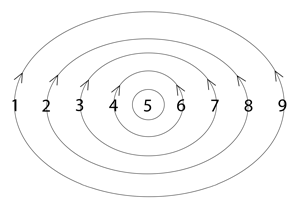real
6-3-9
Conventional Understanding
“Real” is commonly understood as something that actually exists, not imagined or fake. People sort experiences into “real” or “not real” to decide what deserves attention. Phrases like “get real” or “in the real world” treat realness as an objective quality that exists independent of perception. This creates a hierarchy where certain experiences are validated while others are dismissed as “just imagination” or “just emotions.” Treating “real” as a property of objects rather than an aspect of experience itself dismisses significant portions of lived experience.
Resonant Understanding
The word “real” has a numeric pattern of 6-3-9. This positions it at the completion point (Position 9) of the creative sequence, where experience becomes fully integrated.
Think of how a river both shapes and reflects the landscape it flows through. Similarly, “real” doesn’t determine what exists but shows where experience and reflection meet. Just as water vapor becomes visible as fog, and fog becomes rain that flows as a river, “real” represents the point where the cycle of creation completes and potentially begins anew.
Words like “appreciate the reflection,” “care,” and “experienced reality” share this same pattern, suggesting realness relates to direct experience that has been fully integrated through reflection.
Expressions Spectrum Analysis
When expressed in a balanced way, this pattern appears as “creative expression of mind,” “appreciate the reflection,” and “care.” These show how realness naturally involves recognition and response. “Experiencing reality” shows direct engagement with what appears in awareness. “True reflection” shows how balanced expressions bring coherence without fragmenting experience through judgment.
When pushed too far, the pattern becomes “rationality,” “control system,” and “forcing,” showing how realness becomes rigid and manipulative. “Becoming an identity” shows how reflection gets distorted through excessive self-reference. “Seeker” and “search” show how over-modulation creates endless pursuit instead of simply recognizing what’s already present.
When under-expressed, we see “benign neglect,” “denial,” and “despair,” showing what happens with insufficient engagement. “In the dark” and “the emptiness” reveal the confusion when awareness disconnects from experience. “Damned if you do, damned if you don’t” shows the stalemate when experience cannot be integrated coherently.
Russell’s Cosmogony Connection
Walter Russell writes: “This universe is substanceless. It consists of motion only. Motion simulates substance by the control of its opposing wave pressures of motion which deceive the senses into seeing substance where motion alone is.”
This relates to why “real” appears alongside “light waves” in the 6-3-9 pattern. What appears as solid reality emerges through patterns of motion, not fixed objects but dynamic relationships between opposing pressures.
Russell also explains: “Mind thinking sets divided idea into two-way opposed motion to produce the effect of simulating idea by giving form to it. Formed bodies are but pressure-conditioned motion, however. They are not the IDEA which they simulate.”
This suggests that realness emerges not from separate objects but through the relationship between experience and awareness. The 6-3-9 pattern positions “real” at the point in creation where experience has completed its journey through the sequence, from idea (Position 1) through manifestation (Position 6) to integration (Position 9).
Practical Implications
Understanding “real” as the completion point in creation’s sequence transforms how we approach reality. While “abstract” (2-1-3) represents the threshold where potential begins to take form (Position 3), “real” (6-3-9) represents the point where experience has been fully integrated (Position 9).
This challenges narratives that favor external validation over direct experience. Power structures benefit when people doubt their lived experience in favor of “official facts.” When authorities say, “that’s not how the real world works,” they encourage abandoning direct knowing for interpretations that often serve existing power dynamics.
A balanced approach involves neither rigidly controlling reality nor passively accepting whatever appears, but actively engaging with experience through care and integration. This doesn’t mean accepting every thought as equally valid, but developing a more sophisticated relationship with experience.
In practice, this means approaching contradictions with curiosity rather than immediate judgment. It means valuing imagination and intuition as valid aspects of experience rather than dismissing them as “not real.” It means trusting embodied knowing rather than requiring external verification.
When “real” is recognized as a completion point in creation’s cycle rather than a fixed property, it frees us from the false binary of real/unreal. Instead of asking “Is this real?” one might ask “How am I engaging with this experience?” – shifting from verification to participation, from judgment to appreciation.
Walter Russell’s quotes are from his book, “A New Concept of the Universe”.


